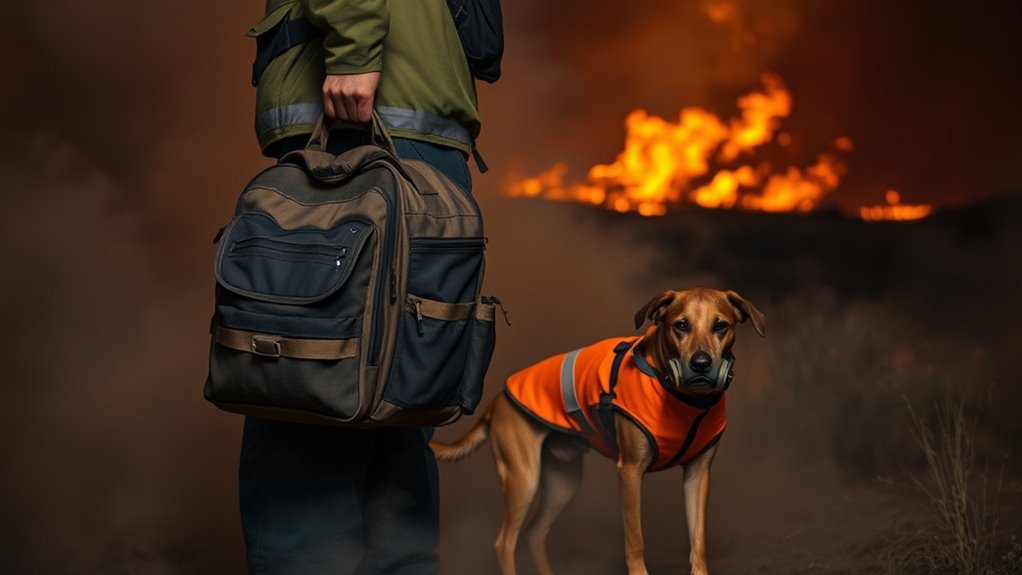During a wildfire emergency, be ready with a pet go-bag that includes food, water, medications, leashes, and familiar comfort items kept in an accessible spot. Protect your pet’s lungs by using masks or coverings specially designed for them to reduce smoke inhalation. Also, consider UV protective gear for outdoor travels. Planning ahead with multiple evacuation routes and practicing drills helps ensure a swift rescue. Keep learning ways to keep your pets safe during wildfires—you’ll find practical tips ahead.
Key Takeaways
- Prepare a pet-specific go-bag with food, water, medications, and comfort items for quick evacuation.
- Include pet masks or coverings in the go-bag to protect against smoke inhalation during wildfires.
- Use UV-protective gear to shield pets’ skin from sun and harmful rays during outdoor evacuations.
- Practice evacuation drills with pets and verify pet-friendly shelters that accommodate animals.
- Keep medical and vaccination records accessible to ensure smooth shelter admission and care.

When wildfires threaten your community, evacuating quickly becomes essential—not just for your safety, but for your pets as well. Proper emergency planning ensures you can evacuate swiftly while keeping your pets safe and comfortable. Having a well-prepared go-bag for each pet is a critical part of this planning. Your pet’s safety depends on your readiness to provide essentials like food, water, medications, and comfort items during an emergency. Think of your pet’s go-bag as an extension of your own emergency kit, tailored to meet their specific needs. Include items such as leashes, harnesses, a familiar blanket, and any necessary medications. Keep these bags in a designated, easily accessible spot so you can grab them instantly when evacuation orders come.
Prepare a pet go-bag with essentials and keep it accessible for quick evacuation.
In addition to pet supplies, respiratory protection plays a crucial role during wildfire evacuations. Smoke and ash can severely impact your pets’ respiratory health, making it vital to have appropriate masks or coverings ready. While humans often rely on N95 masks, pets may need specially designed masks or coverings to reduce smoke inhalation. If your pet has respiratory issues or is particularly sensitive, consider consulting your veterinarian beforehand to find suitable options. During evacuation, keep your pets’ masks or coverings on when exposed to smoky air, and avoid letting them breathe in heavy smoke for extended periods. Protecting their respiratory health not only prevents immediate distress but also minimizes long-term health risks. Additionally, UV protection can help shield your pet’s skin from prolonged exposure to the sun and harmful rays during outdoor evacuations.
Effective emergency planning also involves knowing your evacuation routes and shelters that accept pets. Plan multiple routes in case one is blocked by fire, and always verify that your destination shelters allow animals. Keep your pet’s vaccination and medical records readily accessible, as some shelters require proof of vaccinations. Practice your evacuation plan regularly with your pets so they become familiar with the process, reducing stress during actual emergencies. When you’re prepared, you can act quickly and confidently, ensuring your pet’s safety and well-being.
Ultimately, your pet’s safety during a wildfire depends on your proactive efforts. By investing time in emergency planning, assembling comprehensive go-bags, and having respiratory protection ready, you minimize chaos and keep your pets safe when every second counts. Remember, a well-organized plan not only saves lives but also offers peace of mind during a stressful situation. Being prepared means you’re ready to protect your pets, get to safety swiftly, and face whatever the wildfire throws your way.
Frequently Asked Questions
How Can I Find Pet-Friendly Evacuation Shelters Quickly?
You can find pet-friendly evacuation shelters quickly by checking local emergency management websites and pet rescue organizations, which often list shelter locations. Call your veterinarian or local animal control for recommendations. Use mobile apps or online maps that provide real-time updates on shelter openings. Keep a list of nearby pet-friendly shelters handy. Acting fast guarantees your pets stay safe, and you’ll find the right shelter without unnecessary delays.
What Should I Include in a Pet-Specific Go-Bag?
You should pack a pet-specific go-bag with essentials like pet nutrition, including enough food and water for several days. Include medications, copies of emergency vet contacts, and a first aid kit. Don’t forget a leash, harness, and any comfort items like toys or blankets. Make sure to carry waste bags and cleaning supplies, so you’re prepared for all situations during evacuation, ensuring your pet’s safety and well-being.
Are There Specific Masks Recommended for Protecting Pets From Smoke?
A good respiratory mask can be a lifesaver for your pet during wildfires, but not all masks are created equal. Look for specially designed pet respiratory masks or masks that fit snugly around their snout, offering protection from harmful smoke particles. Remember, your pet’s safety depends on proper fit and filtration, so choose masks rated for smoke and airborne pollutants. Protecting your pet’s respiratory health is essential—you hold their well-being in your hands.
How Do I Keep Pets Calm During Evacuation?
To keep pets calm during evacuation, use pet calming techniques like gentle petting, soothing voices, and familiar blankets. Distraction methods such as toys or treats can also help divert their attention from stress. Keep a calm demeanor yourself, as pets pick up on your emotions. Stay patient and avoid loud noises, providing a sense of security. These strategies help reduce their anxiety during stressful evacuation moments.
What Are the Legal Requirements for Evacuating With Pets?
You must follow legal obligations and pet ownership laws when evacuating with pets. These laws require you to guarantee your pets are safely transported, have proper identification, and are not abandoned. You’re responsible for providing necessary care, preventing cruelty, and respecting local regulations. By understanding these laws, you protect your pets’ safety, avoid legal trouble, and demonstrate responsible pet ownership during emergencies. Always check your local laws before evacuating.
Conclusion
When wildfires threaten, your pets rely on you to be their guardian angel amid the storm. Pack your go-bag with love and essentials, and don respiratory protection to breathe freely through the chaos. Remember, your preparedness is their shield, turning fear into hope. Stand strong, knowing that with every step you take, you’re guiding them toward safety and a brighter dawn beyond the smoky shadows. Together, you can weather any fire.










